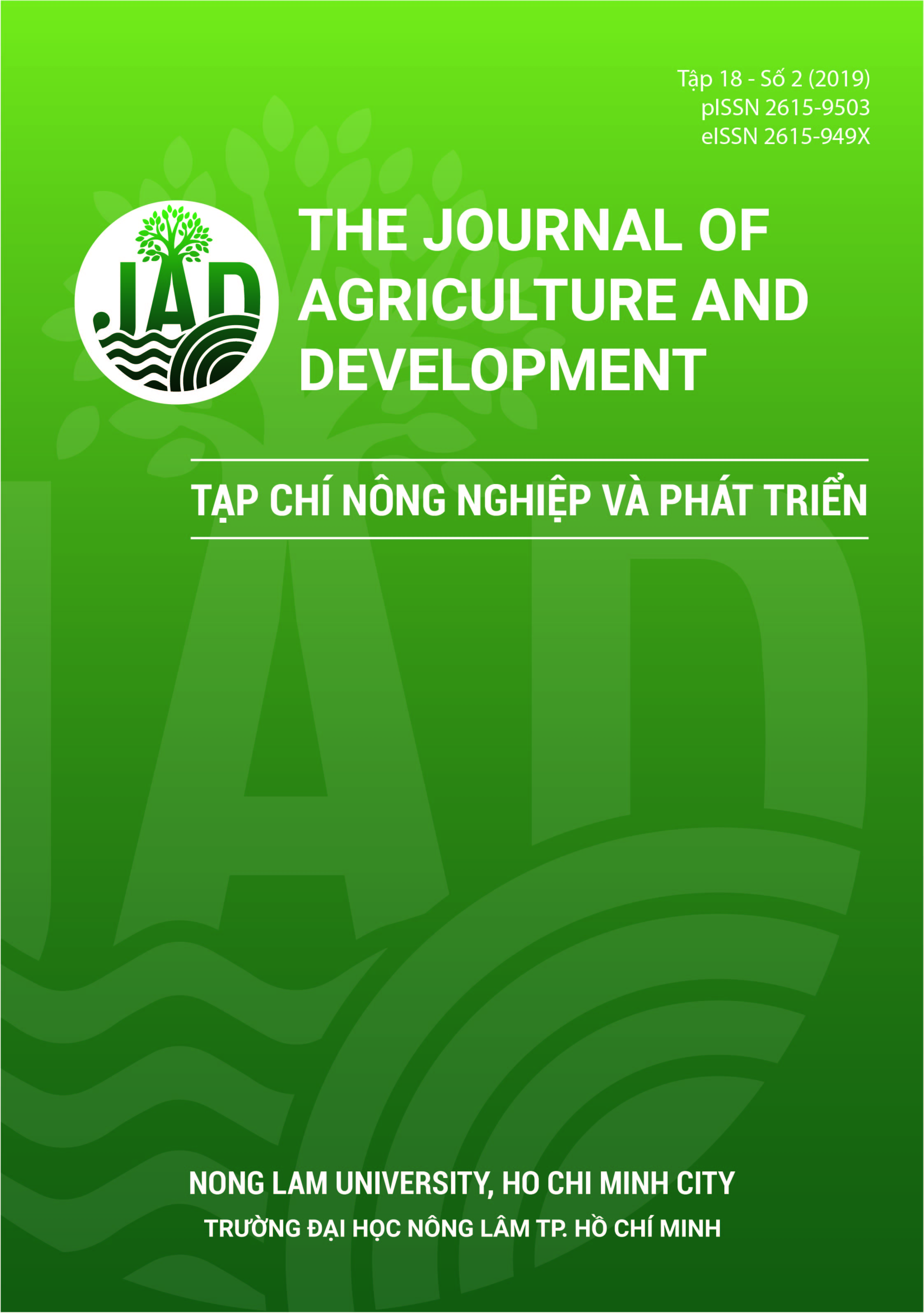Antibiotic resistance of E. coli isolated from whiteleg shrimp (Litopenaeus vannamei) collected from wet markets and supermarkets in Ho Chi Minh city and their transferability
Main Article Content
Abstract
n this study, a collection of 130 E. coli isolated from white-leg shrimp collected from three wet markets and two supermarkets in Ho Chi Minh City was analysed to examine their antibiotic resistance characteristics and the transferability of resistance markers. High levels of resistance to ampicillin, tetracyclines, trimethoprim/sulfamethoxazole, nalidixic acid and chlorampheni-col were observed. The percentage of multiple drug resistance (4 to 10 tested antibiotics) was 73.8%. The multiple antibiotic resistance (MAR) index values of 0.4 to 0.73 (of each sample collection site) indicated that these isolates were exposed to high risk sources of contamination where antibiotics were commonly used. Conjugation experiments demonstrated the successful transfer of all or part of the resistance phenotypes of shrimp isolates to the human recipient strains.
Article Details
References
Andersson, M. I., & MacGowan. A. P. (2003). Development of the quinolones. Journal of Antimicrobial Chemotherapy 51(1), 1-11. https://doi.org/10.1093/jac/dkg212
Bischoff, K. M., White, D. G., Hume, M. E., Poole, T. L., & Nisbet, D. J. (2005). The chloramphenicol resistance gene cmlA is disseminated on transferable plasmids that confer multiple-drug resistance in swine Escherichia coli. FEMS Microbiology Letters 243, 285-291. https://doi.org/10.1016/j.femsle.2004.12.017
Bui, T. K., Bui, H. K., & Bui, T. K. (2001). Antibiotics. Vung Tau, Vietnam: Vung Tau Department of Science and Technology.
Cattoir, V., & Nordmann, P. (2009). Plasmid-Mediated Quinolone Resistance in Gram negative bacterial species: An update. Current Medicinal Chemistry 16(8), 1028-1046. https://doi.org/10.2174/092986709787581879
Chu, Y. T. H., Pham, G. T. H., Nguyen, H. T. H., Tran. T. N., & Ho, H. T. (2014). Observation the rate of antibiotic resistance of the isolated bacteria at Trung Vuong hospital. Ho Chi Minh City Journal of Medicine 18(5), 75-82.
CLSI (Clinical and Laboratory Standards Institute). (2012). Performance standards for antimicrobial susceptibility testing; Twenty Second Information Supplement, M100-S22, Vol. 32 No. 3, Replaces M100S21, Vol. 31 No. 1 (Clinical and Laboratory Standards Institute). Retrieved Septermber 1, 2018, from http://zums.ac.ir/files/health/pages/ill/azmayeshgha h/clsi_2013.pdf.
Cooke, E. M., Ewins, S., & Shooter, R. A. (1969). Changing faecal population of Escherichia coli in hospital medical patients. British Medical Journal 4, 593-595. https://doi.org/10.1136/bmj.4.5683.593
Crump, J. A., Medalla, F. M., Joyce, K. W., Krueger, A. L., Hoekstra, R. M., Whichard, J. M., Barzilay, E. J., & Group, E. I. P. N. W. (2011). Antimicrobial resistance among invasive nontyphoidal Salmonella enterica isolates in the United States: National antimicrobial resistance monitoring system, 1996 to 2007. Antimicrobial Agents and Chemotherapy 55, 1148-1154. https://doi.org/10.1128/AAC.01333-10
Heuer, O. E., Kruse, H., Grave, K., Collignon, P., Karunasagar, I., & Angulo, F. J. (2009). Human health consequences of use of antimicrobial agents in aquaculture. Clinical Infectious Diseases 49(8), 1248-1253. https://doi.org/10.1086/605667
Krumperman, P. H. (1983). Multiple antibiotic resistance indexing of Escherichia coli to identify high-risk sources of fecal contamination of foods. Applied and Environmental Microbiology 46, 165-170. https://doi.org/10.1128/aem.46.1.165-170.1983
MARD (Ministry of Agriculture and Rural Development). (2016). Circular 10/2016/TT-BNNPTNT “Promulgating list of veterinary drugs permitted to be marketed and banned from use in Vietnam, and announcement of hs codes of imported veterinary drugs permitted to be marketed in Vietnam”. Ha Noi, Vietnam: MARD Office.
MARD (Ministry of Agriculture and Rural Development). (2014). Circular 08/VBHN-BNNPTNT “Promulgation of list of banned and restricted drugs, chemicals, and antibiotics”. Ha Noi, Vietnam: MARD Office.
Marshall, B. M., & Levy, S. B., (2011). Food Animals and Antimicrobials: Impacts on Human Health. Clinical Microbiology Reviews 24, 718-733. https://doi.org/10.1128/CMR.00002-11
Martínez-Martínez, L., Pascual, A., & Jacoby, G. A. (1998). Quinolone resistance from a transferable plasmid. The Lancet 351,797-799. https://doi.org/10.1016/S0140-6736(97)07322-4
MOH (Ministry of Health). (2018). Decision 3126/QĐBYT “Promulgating guidelines for diagnosis, treatment and prevention of tuberculosis”. Ha Noi, Vietnam: MOH Office.
MOH (Ministry of Health). (2016). Typhus abdominalis. Retrieved August 28, 2018, from
http://vncdc.gov.vn/vi/danh-muc-benh-truyennhiem/1099/benh-thuong-han.
MOH (Ministry of Health). (2009). Report on the use of antibiotics and antibiotic resistance in 15 hospitals in Vietnam 2008-2009. Joint report of Vietnam Ministry of Health and Global Antibiotic Resistance Partnership, Vietnam and Oxford University Clinical Research Unit. Ha Noi, Vietnam: MOH Office.
Neuhauser, M. M., Weinstein, R. A., Rydman, R., Danziger, L. H., Karam, G., & Quinn, J. P. (2003). Antibiotic resistance among Gram-negative bacilli in US intensive care units: implications for fluoroquinolone use. The Journal of the American Medical Association 289(7), 885-888. https://doi.org/10.1001/jama.289.7.885
Nguyen, K. H. N. (2012). Molecular characterisation of antibiotic resistant bacteria isolated from farmed catfish and humans in Vietnam (Unpublished Doctoral’ dissertation). RMIT University, Australia.
Pham, D. V., Nguyen, T. S., & Hua, N. M. (2012). Investigation on antibiotic resistance of pathogenic bacteria in Thong Nhat Hospital, Dong Nai from 06/2011 to 04/2012. Thematic report, Dong Nai Department of Health.
Sarter, S., Nguyen, K. H. N., Hung, L. T., Lazard, J., & Montet, D. (2007). Antibiotic resistance in Gram-negative bacteria isolated from farmed catfish. Food Control 18(11), 1391-1396. https://doi.org/10.1016/j.foodcont.2006.10.003
Schwarz, S., Kehrenberg, C., Doublet, B., & Cloeckaert, A. (2004). Molecular basis of bacterial resistance to chloramphenicol and florfenicol. FEMS Microbiology Reviews 28(5), 519-542. https://doi.org/10.1016/j.femsre.2004.04.001
Serrano, P. H. (2005). Responsible use of antibiotics in aquaculture (Food and Agriculture Organization of the United Nations). Retrieved September 15, 2018, from http://www.fao.org/3/a-a0282e.pdf.
Tonguthai, K., Chinabut, S., Somsiri, T., Chanratchakool, P., & Kanchanakhan. S. (1999). Diagnostic produres for finfish diseases (AAHRI - Aquatic Animal Health Research Institute). Bangkok, Thailand.
Tran, G. T. T., Nguyen, N. T., Nguyen, T. V., Nguyen, H. T. L., Vuong, V. X., Uong, N. N. D., Pham, T. M., & Cao, N. H. (2014). Research on the infectiousness and antibiotic resistance of E.coli isolated from foods in Pasteur Institute, Ho Chi Minh City. Journal of Science 61, 164-170.
Tran, T. T. T., & Nguyen, B. T. (2014). Antibiotic resistance of Bacteria isolated in the microbiology lab of laboratory department of An Binh hospital from 1/10/2012 to 31/5/2013. Ho Chi Minh City Journal of Medicine 18(1), 296-303.
Van, T. T. H., Moutafis, G., Tran, L. T., & Coloe, P. J. (2007). Antibiotic resistance in food-borne bacterial contaminants in Vietnam. Applied and Environmental Microbiology 73, 7906-7911. https://doi.org/10.1128/AEM.00973-07








